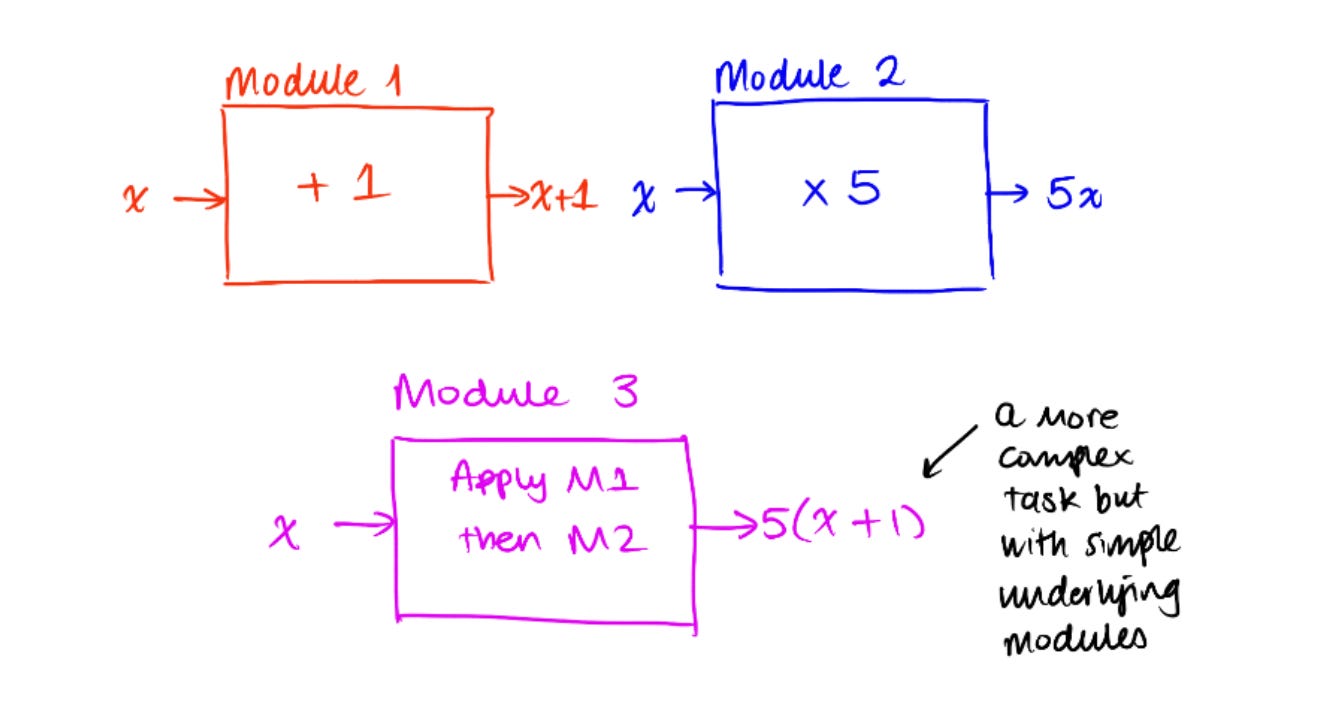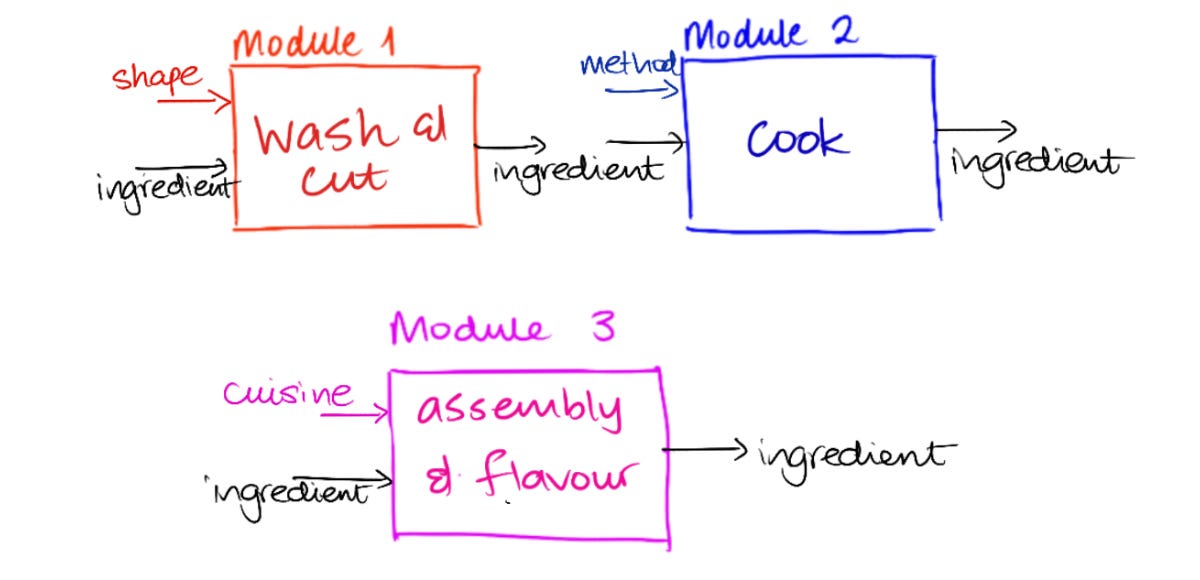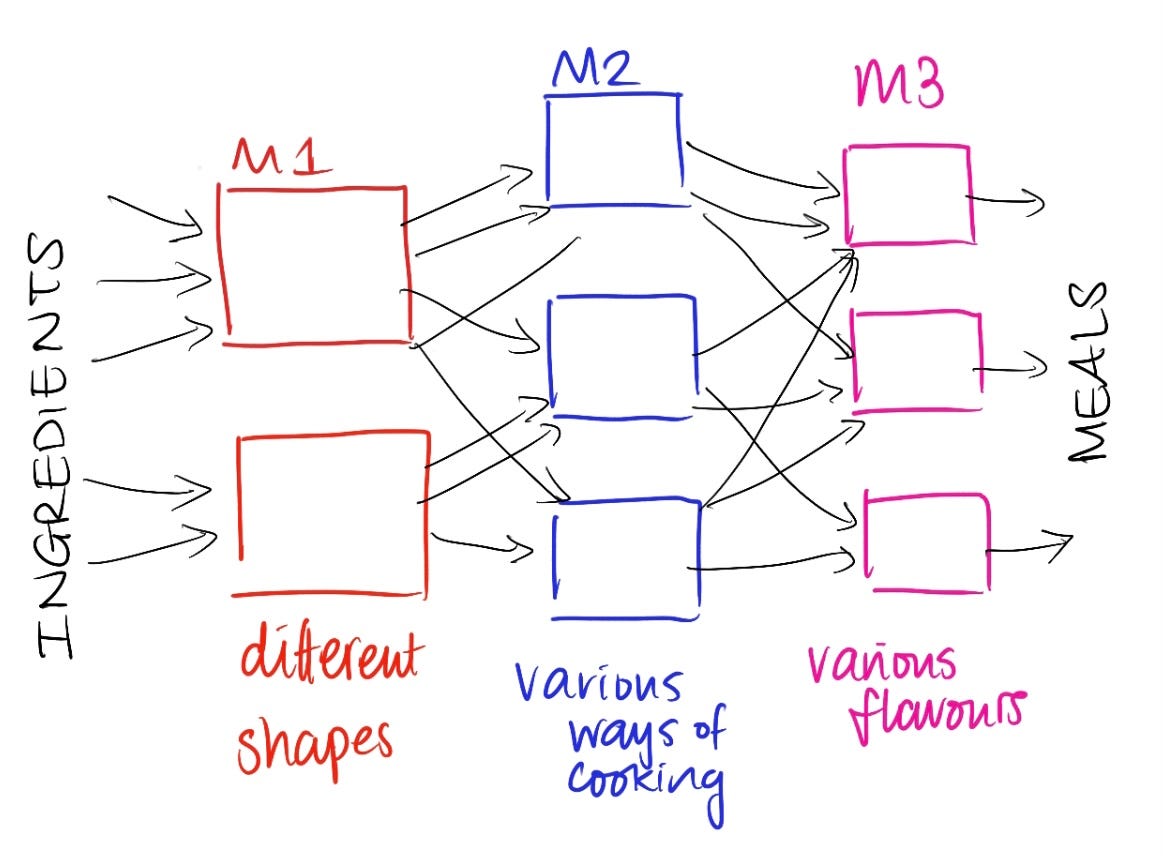Modular Cooking
From writing code to non-repetitive meal preps
As much as I love cooking, being responsible for 3 meals a day 7 days a week can be exhausting, especially with a full-time job.
Before COVID, my workplace had a canteen which served both breakfast and lunch, and with occassional restaurant visits and takeaways, I only needed to cook about 7 meals a week. Now, it’s three times that number.
Even with a flatmate helping to prep meals and eat through food, for most of the first lockdown, I still struggled to balance between the joy of thinking about food and the stress of coming up with dinner solutions that is delicious and nutritious.
On top of that, ingredients always came in huge portions — even if you buy at a farmers’ market. This ends up being a big problem for a lot of my female friends, whether they live alone or in shared flats.
The common answer? MEAL-PREP.
The problem though, I don’t really want to eat the same meals 3 days in a row, no matter how delicious it may be.
And I know a lot of my foodie friends have the same problem; it’s generally hard to balance efficiency and variability.
This is when a coding concept came to rescue.
MODULARISATION.
A Very Brief Introduction to Modular Programming
The concept is pretty simple, Wikipedia's definition pretty much nails it:
Modular programming is a software design technique that emphasizes separating the functionality of a program into independent, interchangeable modules, such that each contains everything necessary to execute only one aspect of the desired functionality.
The key here is the concept of modules, and how each module should be independent and interchangeable. Extending this, it is usually common practice to each module only performing relatively simple tasks.

The advantage lies in the fact that since each module comes in ‘bitesize’, it’s easier to understand, reuse, and improve the modules. To increase complexity, you can just write modules which combine other modules, instead of having having one massively complicated script.
Now, translating this into food…
Meal-prep can be done in a modular way, such that you can eat distinctively different dishes every meal even if they share most of the same ingredients.
Of course, this doesn’t work for complicated dishes, but it works for a lot of things that I would cook and eat during weekdays, namely salads, stir fries, soups. The idea can also be extended to toppings/fillings for a quick pie/galette, quiche, or pizza.
You can modularise said types of dishes easily because a lot of their recipes read like this:
[verb] the [ingredient], and set aside
[another verb] the [another ingredient], and set aside
In a [cookware], add [ingredients], and [verb]
Finish with [final set of ingredients]
When tasks start getting repetitive, you can modularise it.

Rearranging this into a flow-chart for cooking different dishes, we get something like:
Notice how any steps (cubes) in each colour can technically be replaced with another step in the same colour before going to the next step? Interchangeable, check.
Also notice how the cubes in the same colour are not pre-requisites of each other? Independent, check.
Now that we have recipes broken down to independent and interchangeable modules, we can fit them easier into our working lives.
The Implementation: practical steps to get started.
Now that we have the high-level idea, let’s make it real with some steps and examples. So here’s what you have to do instead of your normal meal-prepping:
On your meal-prep day, wash/cook your ingredients individually, each ingredient may be cooked in slightly different ways.
Store them in separate Tupperwares in the fridge
On the day of eating (or the day before), assemble your meal(s) by adding in your selection of flavours, this usually takes me less than 10 minutes.
To make this more concrete, below is an example of how I would meal-prep for one week. With just over 20 ingredients, I managed 10 distinctively different styles of meals, just enough for workday lunches and dinners.

A Note on Meat/Seafood (sometimes tofu)
Preparing meat or fish is somewhat less straight-forward, because you want to add excitement by marinating, as they don’t soak up flavours as easily as vegetables. Here are some options for the meal-prep stage:
Poach then marinate — use for salads or chunky soups (chicken, seafood)
Marinate and keep in fridge for 1-2 days — for stir-fries, Chinese style soups or steamed dishes
Marinate and velvetting* — stir fries (*if you are not sure how to do this we can talk about this another time)
In addition, if you have left-over protein from stir fries, you can always add them to salads or make fancy sandwiches.
Tips for Success
To optimise your happiness and the range of food you can cook with this idea, here are some useful tips:
PLANNING is key: you need to identify which dishes can have overlapping ingredients to maximise your meal-to-ingredients ratio.
BUILD A FLAVOUR CUPBOARD: maintain a range of spices/sauces/pastes that you can mix & match to create bold flavours in various cuisines. (Given you are reading my newsletter and it’s been a year of lockdown, you’ve probably got this sorted.)
Simple PICKLES are worth making/having, they add SO much more interesting texture and flavour to dishes at the assembly stage.
DRESSINGS and DIPS: Make your own. So easy to do and your food will be so much more versatile when you come to assemble the meals, whether it’s a salad, soup, or just something on toast. They will store 2-3 weeks in the fridge.
Mix SALADS in the morning. To let the dressing do its magic.
TOASTED NUTS: Again, very little effort — just toast in the oven next time you bake — but a great way to add flavour and crunch to your meals.
INVEST in tools/Tupperware. I would recommend a good grater for topping dishes with cheese or citrus zest, and a blender for all your smoothies, soup, dressings, and dips.
Afterword
I originally planned to write a post about reducing food-waste. After talking to some of my friends, however, I realised that cooking regularly at home on top of work is perhaps a bigger challenge.
When you buy food that comes in large quantities and follow set recipes, you tend to not only eat the same dishes for multiple days, but also have little bits of ingredients left here and there. Both create opportunities for food waste.
Personally, I try my best to minimize waste in daily cooking, and through this post I formalise how I work towards that goal. I hope this post provides a different perspective on how you could tackle the meal-prep problem, and through this process, perhaps you could waste less food too.
I still plan to write a dedicated post on reducing waste in the future. If you have any problems or tips to do with the subject, please reply to me via email, DM me on Instagram, or leave a comment here! :)
Finally, as always, thank you so much for reading.



